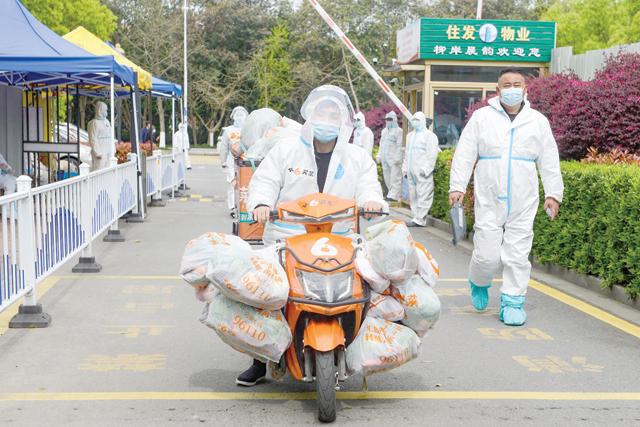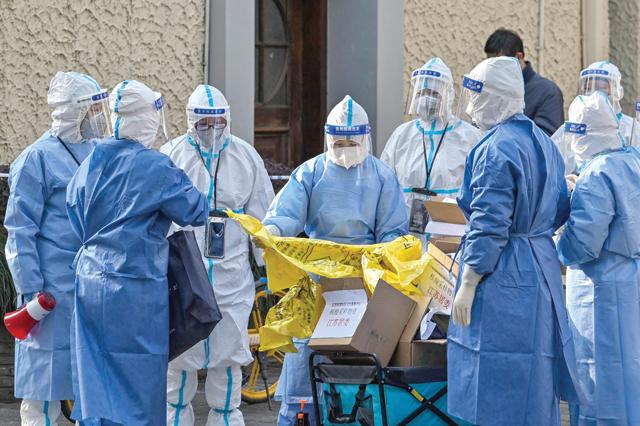You are here
Half of Shanghai in lockdown to curb COVID-19 outbreak
By AFP - Mar 28,2022 - Last updated at Mar 28,2022

A transit officer, wearing a protective gear, controls access to a tunnel in the direction of Pudong district in lockdown as a measure against the Covid-19 coronavirus, in Shanghai, on Monday (AFP photo)
SHANGHAI — Millions of people in China's financial hub were confined to their homes on Monday as the eastern half of Shanghai went into lockdown to curb the country's biggest ongoing COVID-19 outbreak.
The move, announced late Sunday, caused a run on grocery stores by residents who have become exasperated with authorities' inability to snuff out the outbreak despite nearly three weeks of increasingly disruptive measures.
Authorities are imposing a two-phase lockdown of the city of about 25 million people to carry out mass testing.
The government had sought to avoid the hard lockdowns regularly deployed in other Chinese cities, opting instead for rolling localised lockdowns to keep Shanghai's economy running.
But Shanghai has in recent weeks become China's COVID hotspot, and on Monday another record high was reported, with 3,500 new confirmed cases in the city.
The area locked down on Monday is the sprawling eastern district known as Pudong, which includes the main international airport and glittering financial centre.
The lockdown will last until Friday, then switch to the more populated western Puxi section, home to the historic Bund riverfront.
The government said the steps were being taken to root out infections “as soon as possible”.
The unpredictable neighbourhood-level measures employed in recent weeks have left many citizens frustrated with repeated, brief confinements at home.
Some complained Monday that only several hours’ notice was given for the new, larger lockdown.
“We really don’t understand Shanghai’s management and control measures. There has indeed been some inconsistency,” said a 59-year-old man who gave only his surname Cao as he queued to buy groceries.
“After so much time, [the city] is not controlling the virus and the numbers are still going up.”
The government has not specified any impact on Shanghai’s main international airport or its bustling seaport.
‘Not optimistic’
China largely kept the virus under control for the past two years through strict zero-tolerance measures including mass lockdowns of cities and provinces for even small numbers of cases.
But Omicron has proven harder to stamp out.
China has reported several thousand new daily cases for the past two weeks.
Those numbers remain insignificant globally but are up sharply from fewer than 100 a day in February.
Tens of millions of residents in affected areas across China have been subjected to citywide lockdowns in response.
But as Shanghai has struggled, some cities have made progress.
The southern tech manufacturing hub Shenzhen, which locked down earlier in the current outbreak, announced that normal business activity was resuming on Monday as new cases have dropped.
“I didn’t think it will be so serious [in Shanghai],” said resident Guo Yunlong, 24.
“Every single detailed aspect of our lives from clothing, food, living and commuting has been affected. I don’t feel optimistic, to be honest.”
Some online posts complained of the impact on elderly Shanghai residents who may not know how to order supplies online.
Other users accused Shanghai, which is envied by other cities for its wealth and cosmopolitan image, of putting its desire to maintain normality over health concerns.
Chinese authorities have watched nervously as a deadly Hong Kong Omicron surge sparked panic buying and claimed a high toll of unvaccinated elderly before later surging in mainland China.
Related Articles
SHANGHAI — At home in Pudong district, on reduced pay and playing computer games to lift the gloom, 25-year-old Chinese engineer Terry is in
SHANGHAI, China — China reported 13,000 COVID cases on Sunday, the most since the peak of the first pandemic wave over two years ago, as hea
SHANGHAI — Shanghai authorities on Wednesday called for calm as worried citizens swamped online grocery platforms to stock up on food over f














